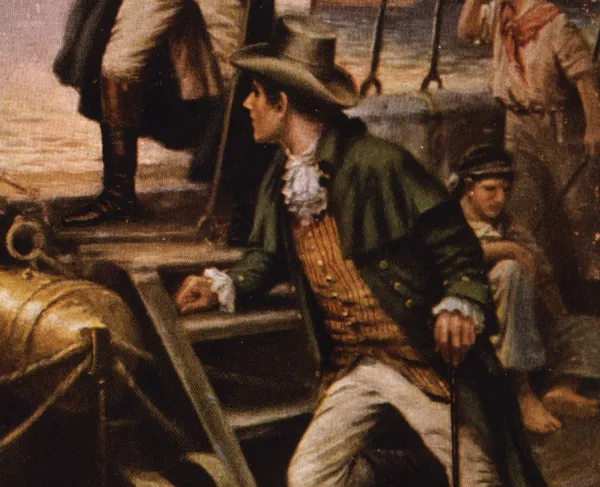Dr. William Beanes

Dr. William Beanes was born on January 24, 1749, in Croom, a small town in Prince George’s County, Maryland. As a small child, Beanes grew up in an affluent home. Beanes’ parents were wealthy landowners; however, Beanes received a public education. Upon completing his public education, Beanes wanted to learn medicine to become a doctor. Since there was no official medical college in the 13 Colonies, Beanes’ parents hired a local doctor to teach him.
Upon the shot heard round the world at Lexington and Concord, Beanes offered his medical expertise following the battle at the General Hospital in Philadelphia. Following his service at the General Hospital, Beanes attended to wounded soldiers on the frontlines after the battles of Brandywine, Long Island, as well as through the winter at Valley Forge. Following Beanes’ service in the Revolution, Beanes settled in Upper Marlboro, Maryland where Beanes became a respected doctor in the region. In 1799, Beanes, along with doctors John and Thomas Archer, established the Medical Chirurgical Faculty of Maryland, now known as the Maryland State Medical Society.
Beanes played a much larger role in the War of 1812. In the summer of 1814, British forces sailed up the Chesapeake Bay landing several regiments of soldiers along the Patuxent River. Marching up to Upper Marlboro, the British noticed that the town was deserted, except for Dr. Beanes, who offered his home as a base of operations for the British. Thinking that Beanes was sympathetic to the British, they used his home as a base of operations for the Battle of Bladensburg and the burning of Washington, D.C. in August of 1814. Soon after the burning of Washington, British deserters went in search of food. The deserters ransacked local farms nearby, one of the farms was owned by the 11th Governor of Maryland, Robert Bowie. Bowie, enraged, asked anyone in the area to assist in tracking down the British deserters and take matters into their own hands. Dr. Beanes caught wind of Bowie’s call for help and asked Doctors William Hill and Philip Weems to help. The group arrested a small number of the deserters and confined them in the Prince George’s County Jail. One of the deserters managed to escape from the jail and promptly scurried to the British ships in Southern Maryland. After hearing the news, General Ross and Admiral Cockburn ordered the arrest of the three doctors. By the end of August, Doctors William Hill and Philip Weems were released. However, the British would not release the now 65-year-old doctor under the pretense that the British believed he was a spy.
After learning that Beanes would not be released, Beanes’ friends hurried to Georgetown to meet with a prominent lawyer, Francis Scott Key. Key, a Frederick, Maryland native and prominent Georgetown lawyer, decided to go with Prisoner Exchange Colonel John Stuart Skinner to negotiate Beanes’ release. Upon arriving on the HMS Tonnant, the British decided that Beanes was no longer a threat or a spy. However, the British would not allow the three Americans to leave the Tonnant due to them knowing too much about the British positions in the Chesapeake Bay. The three were forced to return to the American vessel the President and wait within the ranks of the British Navy until the upcoming Battle of Baltimore was finished. On the morning of September 13, 1814, the Bombardment of Fort McHenry and the battle for Baltimore began. For the next 27 hours, the three Americans watched in horror as the British fired their cannons, firearms, and rockets at Fort McHenry. Throughout the day and into the night, the three could see nothing due to the amount of smoke released into the air. By nightfall, and with the bombs bursting in the air, their view of Fort McHenry was obscured.
On the morning of September 14, the three saw the American flag still flying strongly. The British failed to take Baltimore, and subsequently, left the three Americans to sail back into Baltimore. By September 16, Beanes, Key, and Skinner were all back in Baltimore, safely securing the release of Beanes. Key, with the aid of Beanes, was inspired by what they saw during the bombardment and wanted to write a poem about what happened. Key wrote the “Defence of Fort M’Henry,” to the tune of a popular British song. Eventually, the song was renamed “The Star-Spangled Banner” and became a well-known song across the new nation. Its use as a national anthem wasn’t until 1931 when President Herbert Hoover made the song the official national anthem. Beanes, incidentally, was the reason that Key was able to write the poem.
Beanes spent the remainder of his life living in his home in Upper Marlboro. William Beanes passed away in his home on October 12, 1828. Beanes’ legacy lives on through his capture as a possible spy, and Key’s monumental poem. While serving as a doctor in the Revolutionary War, Beanes also helped play an unsuspecting role in the War of 1812, the incidental inspiration for the Star-Spangled Banner.





